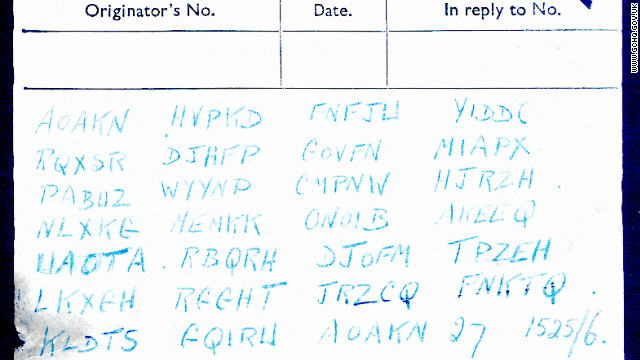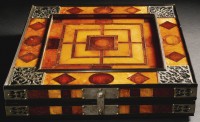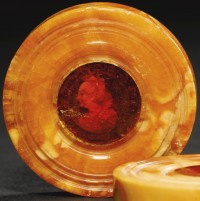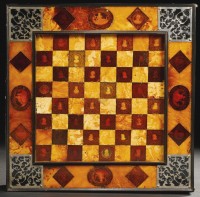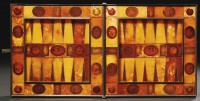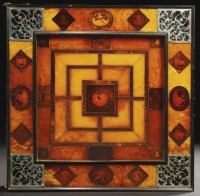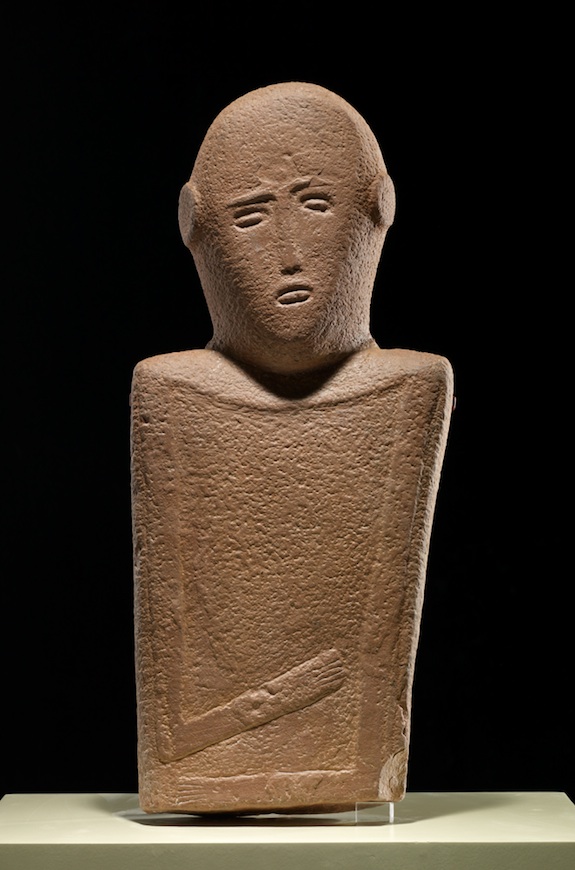Monday, December 17, 2012
Resurrecting the ancient city of Laodicea
Cranes, excavators, teams of workmen in hard-hats and foremen shouting into their mobile phones are a ubiquitous feature of today's Turkey, a country where, in spite of a global economic slowdown, new buildings continue to be erected at a staggering rate. Take a trip to Laodicea, however, and you'll see a “building site” with a twist. For here a long abandoned Greek-Roman city is being resurrected wholesale from its ruins by … construction cranes and teams of workmen in hard-hats!
 Sprawling across a low hill between the prosperous textile town of Denizli and the iconic travertine formations of Pamukkale in western Turkey, ancient Laodicea is generally overlooked by the vast majority of visitors, who tend to be drawn instead to Pamukkale and its associated site of Hierapolis, or the wonderful remains at Aphrodisias, not too much further away. Only bible groups, attracted to Laodicea because it is one of the Seven Churches mentioned in the New Testament's Revelation of John, buck the trend.
Sprawling across a low hill between the prosperous textile town of Denizli and the iconic travertine formations of Pamukkale in western Turkey, ancient Laodicea is generally overlooked by the vast majority of visitors, who tend to be drawn instead to Pamukkale and its associated site of Hierapolis, or the wonderful remains at Aphrodisias, not too much further away. Only bible groups, attracted to Laodicea because it is one of the Seven Churches mentioned in the New Testament's Revelation of John, buck the trend.That Laodicea is relatively little visited is hardly surprising given its press. The current edition of Lonely Planet Turkey says “there's not much of interest left,” the Rough Guide to Turkey doesn't even mention the site. A late 1980s version of the more specialist, archaeology and history-orientated Blue Guide writes of Laodicea, “Much of its worked stone has been removed for building purposes and, unfortunately, little is being done to preserve its remaining structures from further damage.”
Columns, capitals and freshly cut marble
The author of the latter guide particularly would be gobsmacked at the momentous changes under way at Laodicea in late 2012. Everywhere you look across the broad, uneven hilltop site are recently re-erected columns, many of which were once an integral part of the colonnades lining the city's grid-plan streets. The carefully grooved columns are surmounted in many cases by flamboyantly carved Corinthian-style capitals, hefty flared blocks decorated with acanthus leaves. Of course you can see re-erected columns at many similar sites across western Turkey, but visit Laodicea today and you can actually see how the reconstruction work is done, with cranes lifting the marble column drums up to the workers on a scaffolded section of colonnade, and blue-hatted workers maneuvering them into position.
 |
| Turkey Laodicea (Photo credit: Wikipedia) |
Inevitably, where a column drum has been lost to the vicissitudes of time, re-erecting the complete column necessitates the insertion of a new one. Add to this the fact that many of the original parts have been cleaned up to blend in with the new, and the overall effect of the gleaming white marble reconstructions can be rather off-putting, for most of us are both used to -- and rather like -- seeing our ancient remains romantically tarnished by the weather and crusted with lichen. But thinking about it, isn't this how the city would have looked like when it was first being built back in the mid-third century B.C. by the Seleucid ruler King Antiochus II for his wife, Laodicea, or rebuilt in even grander fashion following one of the many quakes that devastated the region in the Roman and Byzantine periods, with freshly cut and polished marble dazzling ancient workmen and idle onlookers alike?
A new Ephesus?
To reconstruct ancient buildings or not is, of course, an argument that has long divided archaeologists and historians. Purists argue that ancient sites should be excavated and records kept of what is found but that they should be otherwise left as they are -- if for no other reason than that those involved in the reconstruction might get it wrong. Liberals counter that reconstruction enables both experts and ordinary people alike to better appreciate a building or site, and fosters an interest in the past among the general public that can only be of benefit to the preservation of the past. Fortunately the liberals appear to have won the day at Laodicea, where the excavation and reconstruction work is being carried out under the aegis of Denizli's Pamukkale University.
Newspaper talk of a “second Ephesus” may be a little premature, but there is no doubt that this is going to a major site on western Turkey's tourism circuit -- especially given its proximity to Pamukkale and its New Testament associations. For despite the numerous earthquakes that leveled the city from time to time, it nonetheless prospered and grew to be, at its height in the second and third centuries A.D., a major settlement covering some five square kilometers. Its wealth derived from its location controlling a major trade route between the Aegean and upland Anatolia, the production and export of fine quality wool, and because of the presence nearby of an important shrine to the moon god Men and its associated healing center, which drew in many pilgrims. The city retained its importance until the early sixth century, when it was abandoned after a particularly severe earthquake.
Exploring the site
But apart from the colonnades already mentioned, what is there left to see of this once important city? Once you've negotiated the entry point (admission TL 10, 8:30 a.m.-5 p.m. daily except Monday) the most obvious place to start, just beyond the parking lot and café-cum-souvenir shop, is the southeast gate, also known as the East Byzantine Gate. Using masonry from previous Roman buildings, the gate was part of a defensive fortification thrown up around the city in the late fourth century A.D., a sign that the region was less secure than it had been during the preceding Roman period. The gate opens up onto the city's main thoroughfare, near one kilometer-long and impressively broad Syria Street, its large marble paving flags still in remarkably good condition. Lined on either side by imposing columns, it's every bit as impressive as any Roman street surviving in Turkey bar, perhaps, Curetes Street at Ephesus.
Probably the most intriguing remains are those rather prosaically known today as Temple A, on the north side of Syria Street. Some 19 columns of this temple and its sanctuary area have been re-erected, giving some idea of the vast scale of this place of worship. Enter the well-preserved doorway leading to the main body of the temple, which would have contained a statue of a deity in ancient times, and you find yourself, rather alarmingly until you get used to it, walking on tempered glass set in a steel canopy covering the arched vault below, still littered with finely carved marble statuary.
Further along Syria Street are the remains of the marketplace or agora, right at the heart of the settlement and the focal point of any Greek-Roman town. Just south of it are the so-called Central Baths, the typically monumental structure comprising the changing, warm, hot, super-hot and cold-plunge rooms of a typical Roman bath, very much the model for the later Turkish hamam. The holes where the metal pegs used to fix the marble cladding to the interior can still be seen and, in one spot on the east wall, a fragment of the marble itself is still in place, clinging to the original plaster.
Marble jigsaw puzzles
Marble jigsaw puzzles
Over to the northwest, heading towards the westernmost of Laodicea's two theaters, are neatly piled and labeled stacks, some of marble fragments, others of brick, tile and sections of terracotta water pipe. Recovered from the site by the excavators, these oversized jigsaw puzzle pieces will be painfully pieced back together in whichever building they came from -- or stored in a museum depot somewhere until their fate is decided. Close by, when I visited a couple of weeks ago, local workmen stood in the bottom of deep trenches cut into the accumulated debris of a couple of millennia or so, uncovering a jumble of marble column drums and other architectural pieces from long-tumbled buildings. Above them a massive crane was poised, ready to hoist the remains up and away, its driver listening to shouted instructions from a young, bearded archaeologist, while a tractor and trailer was loaded with earth from the dig.
It was rather a different scene to the one recorded by Society of Dilettante member Richard Chandler, who visited Laodicea in 1764 to record its antiquities. Although he reports seeing many remains, they were either “in a confused heap” or else covered with “risen soil.” The reconstruction of the ancient city and subsequent hordes of tourists envisaged by the Ministry of Culture and Tourism and Denizli's mayor were then unimaginable. Chandler and his party camped on the ruins of the desolate city and he wrote: “All was silence and solitude. Several strings of camels passed eastwards over the hill; but a fox, which we first discovered by his ears peeping over a brow, was the only inhabitant of Laodicea.”
A sight well-worth seeing
There is much else to discover in this sprawling site, from the massive outline of a 25,000-seater stadium to several basilica churches, and it would be easy enough to spend a whole day here. Although the sprawl of Denizli is encroaching upon the environs of Laodicea in the form of skeletal electricity pylons and the like, it remains a beautiful spot, raised up above the valley floor, with grand views across to the mountains on either side. The great white smudge on the hillside to the northwest is the travertine terraces of Pamukkale, behind which lie the remnants of Laodicea's northern neighbor, the spa-city of Hierapolis.
When the excavation and reconstruction work is completed -- which won't be for many years judging by the amount of architectural material still jumbled about the place -- Laodicea may just give Ephesus, another of the Seven Churches mentioned in Revelations, a run for its money in tourism terms. For the moment it is quiet and uncrowded. This sense of solitude, combined with the chance to see an ancient city resurrected, piece by piece, makes Laodicea a “building site” worth seeing rather than avoiding.




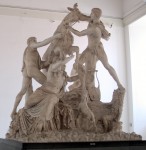






 Samples from the Seedling Growth investigation aboard the International Space Station help researchers study the impact of the microgravity environment on plant growth. (NASA)
Samples from the Seedling Growth investigation aboard the International Space Station help researchers study the impact of the microgravity environment on plant growth. (NASA)  View of the TROPI seedling cassette for the European Modular Cultivation System, or EMCS, aboard the International Space Station Destiny laboratory module during Expedition 14. (NASA)
View of the TROPI seedling cassette for the European Modular Cultivation System, or EMCS, aboard the International Space Station Destiny laboratory module during Expedition 14. (NASA) 
